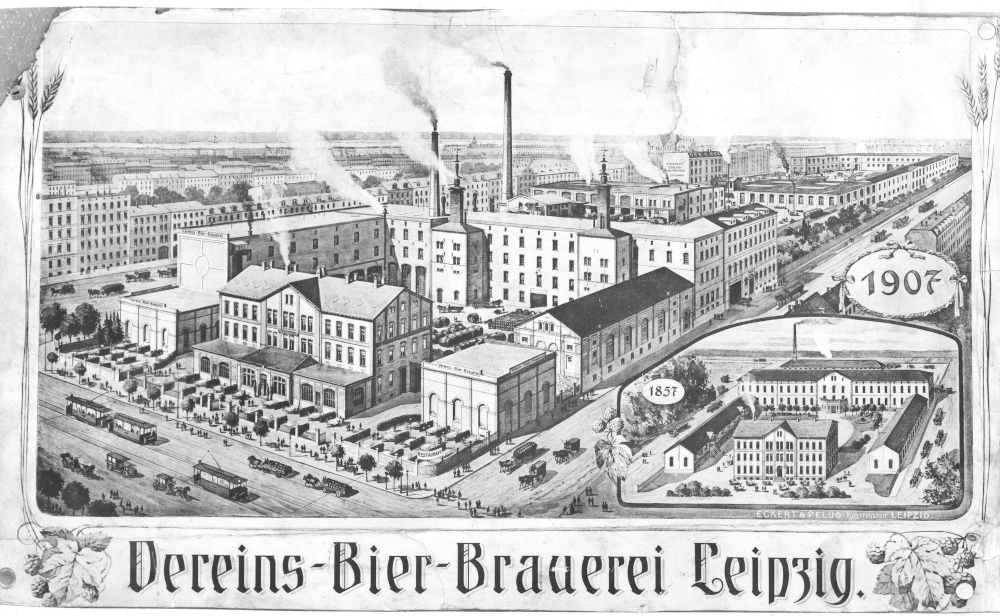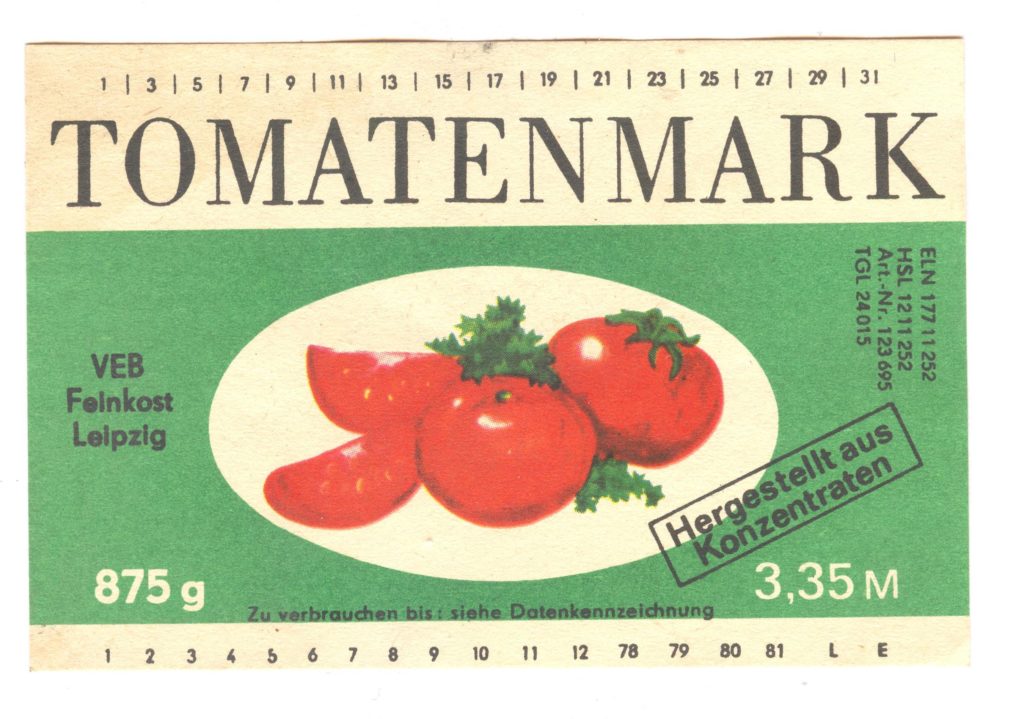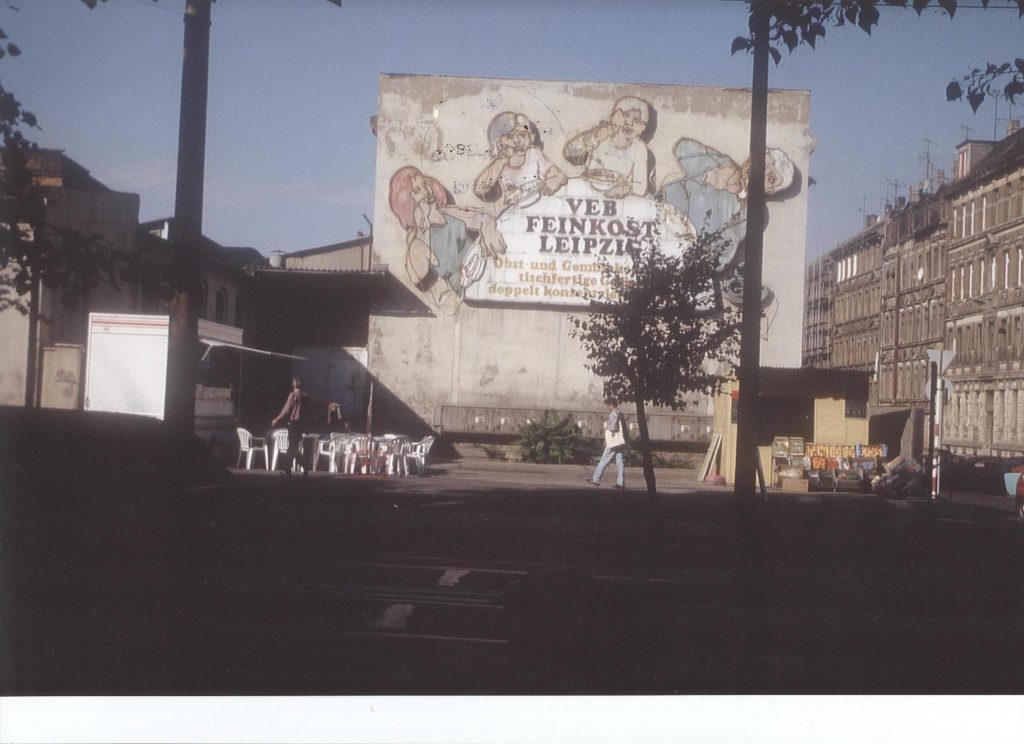The neighboring Braustraße (brewstreet) still points to this today: The Feinkost site was once built as a brewery. Founded in 1852 by Carl August Friedrich Lange on what was then the chaussee to Connewitz, the ‚Langesche Bierbrauerei‘ was transformed into the joint stock company ‚Vereins-Bier-Brauerei zu Leipzig‘ in 1857.
In the mid-19th century, this area was still outside the city gates. Leipzig had 40,950 inhabitants in 1830. The factories soon increasingly settled in the south, because in the 1860s – the population had already doubled – the old town with its successful tradefair business wanted to be kept free of smoke and soot. The brewery, including a restaurant with a dance hall, an outdoor seating area and the later Guild Hall, benefited from the improving infrastructure, the nearby coal train station and the Gohlis-Connewitz horse-drawn tram line. Thus, the brewery became a popular excursion destination and social establishment in the midst of Südvorstadt, which was further developed through targeted urban planning. At the end of the 19th century, it reached its economic and constructional peak.
The end of the ‚Vereins-Bier-Brauerei was brought about at the beginning of the 20th century, primarily by the outbreak of the First World War – together with a shortage of raw materials and falling sales. In 1921, the Plagwitz brewery ‚C.W. Naumann AG‘ took over the brewing rights and shut down production.

At the beginning of the 1920s, people in the cities suffered from housing shortages, rising rents and inadequate food. And yet there was a wide range of cultural offerings for Leipzig’s more than 700,000 inhabitants. In the numerous cinemas, cabarets and theaters, the art and cultural scene was able to develop – also on the former brewery site.
Managed by the ‚Grundbesitz-AG zu Leipzig‘, founded in 1925, companies such as the ‚Vereinigte Konservenfabriken Karl v. Hausen und Söhne‘ and the branches of the ‚Weinessig- und Gurkenkonservenfabriken L. Hirsch‘ (from Schweinfurt and Düsseldorf) and Arthur Schindler’s ‚Thüringia Marmeladen und Muskocherei GmbH‘ took up operations in the former production buildings.
The Guild Hall as a large room for theater and festivities, the Guild Cellar and smaller social rooms were connected to the restaurant buildings on what was then Zeitzer Strasse (today Karl-Liebknecht-Strasse) and used for numerous cultural events, including by the Leipzig Billiards Club, the Photo Club and the German Cactus Society.
The literary cabaret Litfaßsäule, founded in 1930 by Leipzig painters and graphic artists Martin Mendelsohn and Siegfried Wisch, first performed with homemade props on an improvised stage in the large Gildensaal and later in the Südbräu restaurant. In addition to amateur actors from the working class, who received 8 Reichsmark per performance, the ensemble also included actors and singers from other Leipzig theaters such as Jenita Santas, Fred Wald, Erna Orth and Werner Wieland. With texts by Leipzig authors such as Rolf Sievers and by Kästner, Zweig, Brecht and Hugo, among others, the Litfaßsäule opposed nationalism and racial hatred. In February 1933, it was forced to close down.
In 1933, what was then Zeitzer Strasse became Adolf-Hitler-Strasse and a dark chapter began in the history of the Feinkost. At least 60,000 women, men and children from all over Europe were obliged to perform forced labor in Leipzig between 1939 and 1945 and were housed here, among other places.
While canning and jam production continued on the former brewery site, the Guild Hall underwent a transformation and was initially used as a meeting hall. From December 1941, the hall (as a dormitory) and the first basement floor (for washing and eating facilities and as a recreation room) were rented to set up a „foreigners‘ camp“ by Junkers Flugzeug- und Motorenwerke AG Dessau for its aircraft construction shipyard, located at Leipzig-Mockau Airport.
From February 1943, the camp was one of three forced labor camps of the Leipzig Chamber of Commerce as „Gemeinschaftslager Südbräu“. Up to 185 men and women from France, Belgium, Ukraine, Hungary and Poland worked for 96 companies in Leipzig. The Guild Hall was destroyed by bombing on February 27, 1945, but the basement floors remained intact. After makeshift repairs, 100 people were again housed from mid-March. It was not until the end of April 1945 that the forced housing ended. Little is known about the fate of the forced laborers.
After the end of the Second World War, the site was first cleared of rubble. Canned food production continued in the undamaged buildings. In 1952, the companies located on the site were merged to form ‚VEB Leipziger Feinkost‘. From then on, this company produced canned vegetables, fruit and meat, spirits, fruit pulp, jams and vinegar.
The beginnings of the VEB (nationally owned company) were marked by structural difficulties. Both the companies that had previously existed individually and the VEB as a whole were not included in the national economic material planning for 1952, which led to bottlenecks in production. In the following years overfulfillment of the planned schedule due to abundant harvests alternated with delivery difficulties due to a shortage of raw materials and supplies.
The production facility of VEB Leipziger Feinkost extended over the entire former brewery site with three partially covered factory yards, the huge cellar vaults and the rebuilt Guild Hall. This became the largest production hall on the site. Here, among other things, the fruit and vegetables were sorted, boiled down and bottled.
At the end of the 1950s, VEB Leipziger Feinkost employed more than 250 people, most of them women. Production workers earned around 3,300 DM (German marks – the name of the GDR currency until 1964) per year. Administrative staff received around 4,600 DM and technical staff around 6,600 DM. Production conditions were sometimes very tough, especially in the huge deep cellars that stretched 12 meters underground over almost the entire site. They had already been built during brewery times in the 19th century. While at that time they were used as cooling and storage rooms, in VEB times the temperature was sometimes 30 to 40 degrees Celsius, because the canned goods filled in the Guild Hall arrived boiling hot in the cellars to be labeled and packaged here. The delicatessen canned goods were supplied to the trade, but also to the Leipzig Tradefair and the National People’s Army.
Over time, the employees of VEB Leipziger Feinkost continued to develop new ready-to-serve canned goods. In 1968, for example, seven new dishes were added to the range (e.g. Szeged goulash and rice with green beans and meat), of which 250 tons were to be produced in the course of the year.
Work was partly done in three shifts, during the so-called „summer initiatives“ also with the support of pupils and students of the commercial college. From January to September 1973, for example, 1.5 million jars of peas and 1.4 million jars of green beans were produced. During the same period, 120,000 jars of cucumbers and 50 tons of boiled and salted cucumbers were delivered to retailers.

With the end of the GDR, the Treuhandanstalt and later the Treuhand Property Company (TLG) also began their activities in Leipzig. VEB Leipziger Feinkost was dissolved and production on the site was shut down in 1992. A discount store moved into the factory outlet and artists, creative people and small businesses gradually settled on the extensive site. The oldest store, which has existed since 1995, is Mrs. Hippie.
Over time, there were repeated plans by TLG to sell the area. In the mid-2000s, TLG finally sought the large-scale demolition of the now listed buildings. However, the Interessengemeinschaft Feinkost fought back, collected around 13,000 signatures under the slogan „Milieuschutz Feinkost Leipzig“ and submitted its own plans for the use of the front courtyard to the city.
In 2004, the Feinkost eG art and business cooperative was founded, which wanted to continue to make the front building ensemble, which still exists today, accessible to the public as a cultural and commercial courtyard. Due to the great public interest, the city intervened as a mediator. At the end of the public tendering process for the site on Karl-Liebknecht-Strasse, the Feinkost eG came out on top in 2006 and became the owner of the site in 2007. In the same year, TLG had the last passage to the second Feinkosthof closed, demolished the buildings there and made room for a discount store.

The Feinkost eG art and trade cooperative was founded on October 20, 2004 from an initiative that campaigned against the demolition of the Feinkost site in the 2000s. It is an association of craftsmen, traders, service providers and artists and currently has 20 members who are located on the site with their stores, workshops and offices.
Small-scale trade and markets, summer theater and summer cinema, colorful events and concerts: Today, Feinkost offers its visitors an artistic-creative atmosphere as well as a retreat in the south of Leipzig that combines its very own historical charm with forward-looking ideas for use.
Democracy, self-initiative, self-administration, self-responsibility and solidarity are central values of the cooperative. The cooperative idea, which was included in the list of intangible cultural heritage by the German UNESCO Commission in 2014, is lived by the members in their daily interaction.
If an industrial monument loses its original use, it can be preserved either as a museum or through a change of use. The aim of the new form of use of the industrial monument should be to preserve the characteristic features as much as possible and to preserve the testimonial value of the buildings. The Feinkost art and business cooperative intends to ensure this in the future. This includes the protection from demolition, the historical refurbishment, the public accessibility and thus the new use in accordance with the preservation order. The continued existence of the buildings is to be secured in the long term.
The uses of the site are to be as diverse as the Feinkost eG itself. The existing cultural offerings in the former industrial courtyard are to be preserved and expanded. In the stores and workshops, the focus will continue to be on artisanal ecology, repair and recycling as well as artisanal, creative production. There is space for offices and studios on the upper floors. The vaulted barrels in the basement are ideally suited for use as event spaces due to their dimensions and construction and will be made usable in the future through appropriate renovation work.